Bloom Chart
In zone 3, the earliest varieties ripen the last week of June, Japanese varieties a couple weeks later.
Facebook Group
Best Intro to Honeyberries (from Europe)
PLANTRA netting
Wholesale 100+ plugs: Contact us
Testimonial
"Being a jam person I received a jar of Honeyberry Jam and 'wow', this is so good. It will make your tongue dance! Seriously, you will not be disappointed. Thanks Honeyberry Farm!" -Joel D.
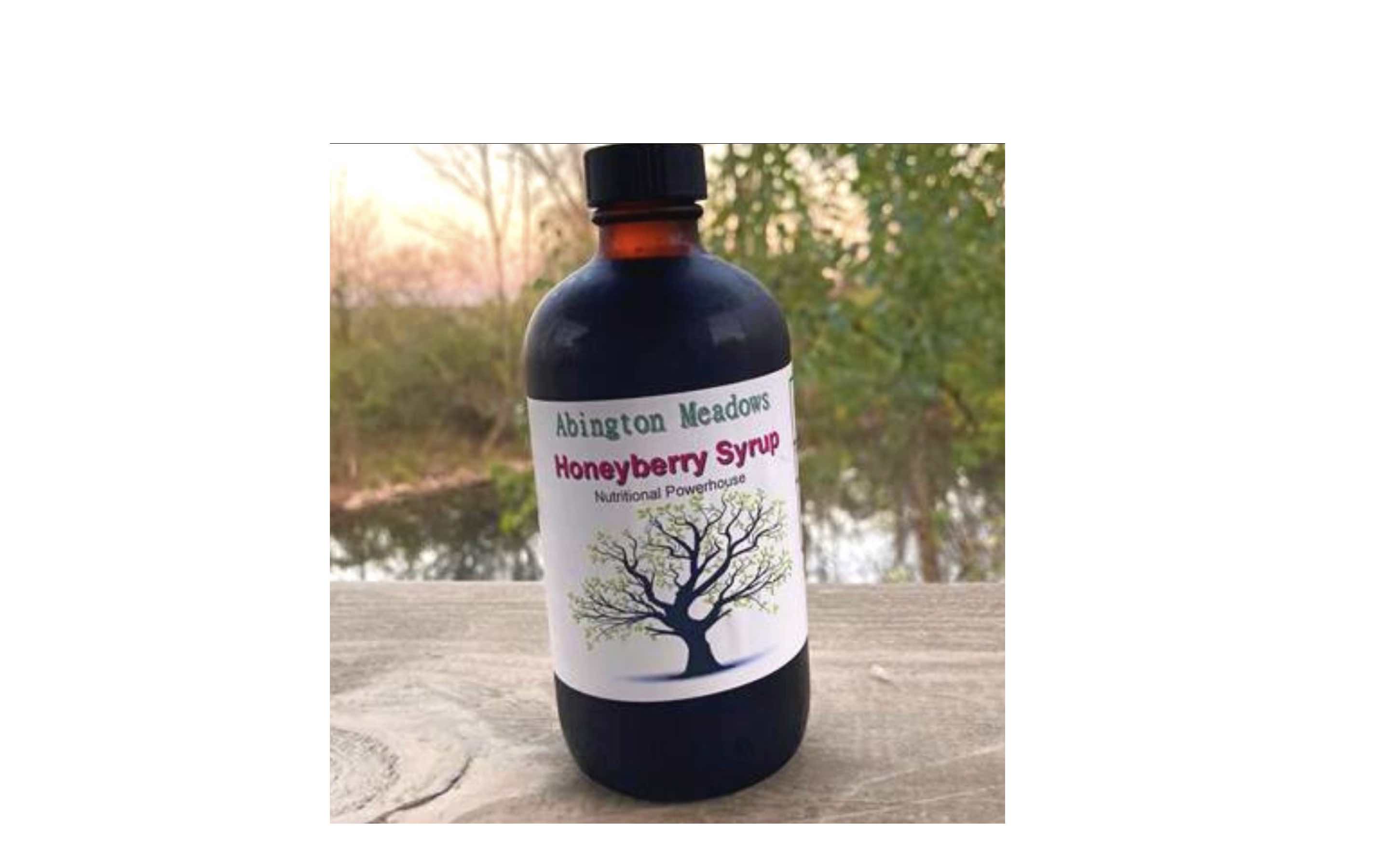 Add some sweetness to your life!
Add some sweetness to your life!
Honeyberry Syrup made from HoneyberryUSA berries, commercially available from
Hidden Pond Farm
PLANT SIZES
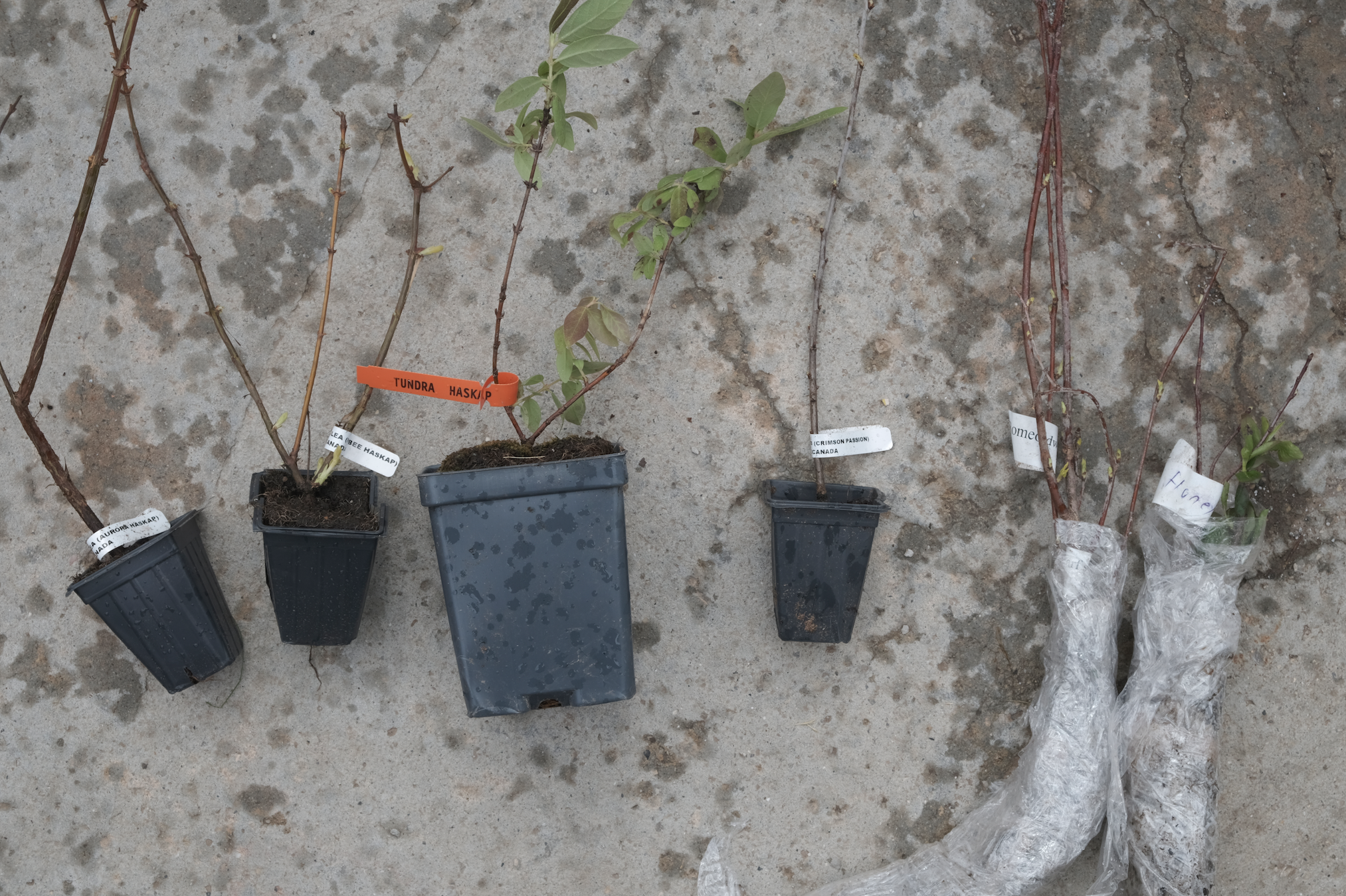
Examples of 2.5" pot (4"-1' tall)
and liter/quart pot
We send dormant plants, partially bare root
whenever possible
and wrap roots to stay moist
during several days transit
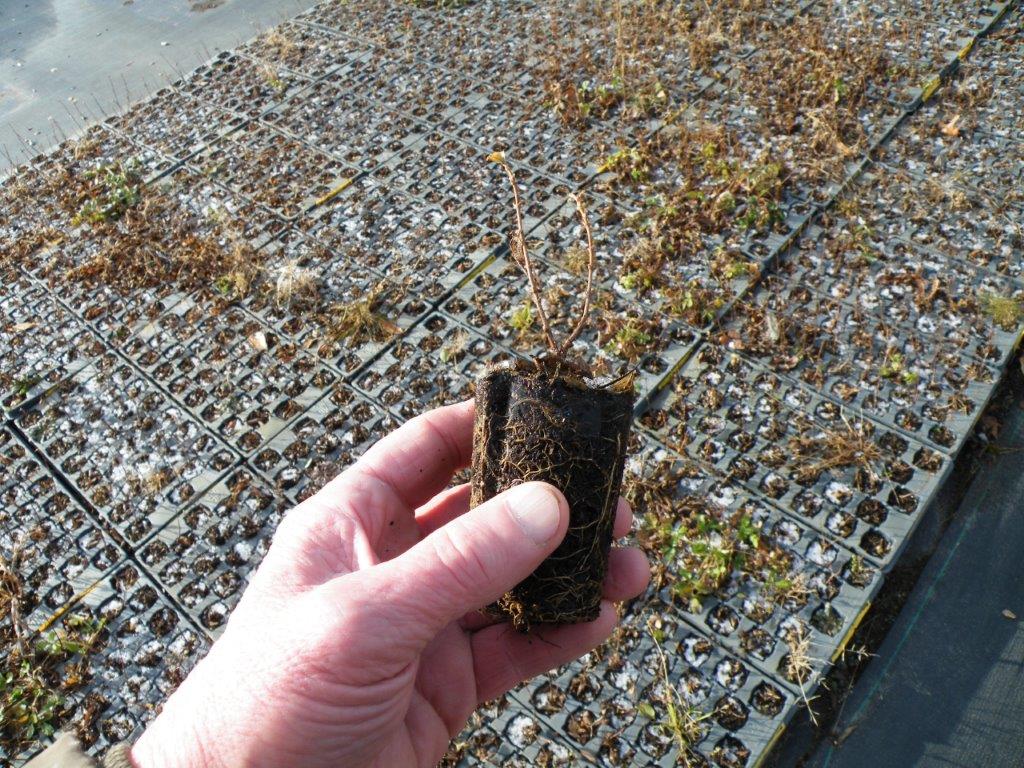
Plants intially grow out in "plugs"
can be planted into pots
or directly into field
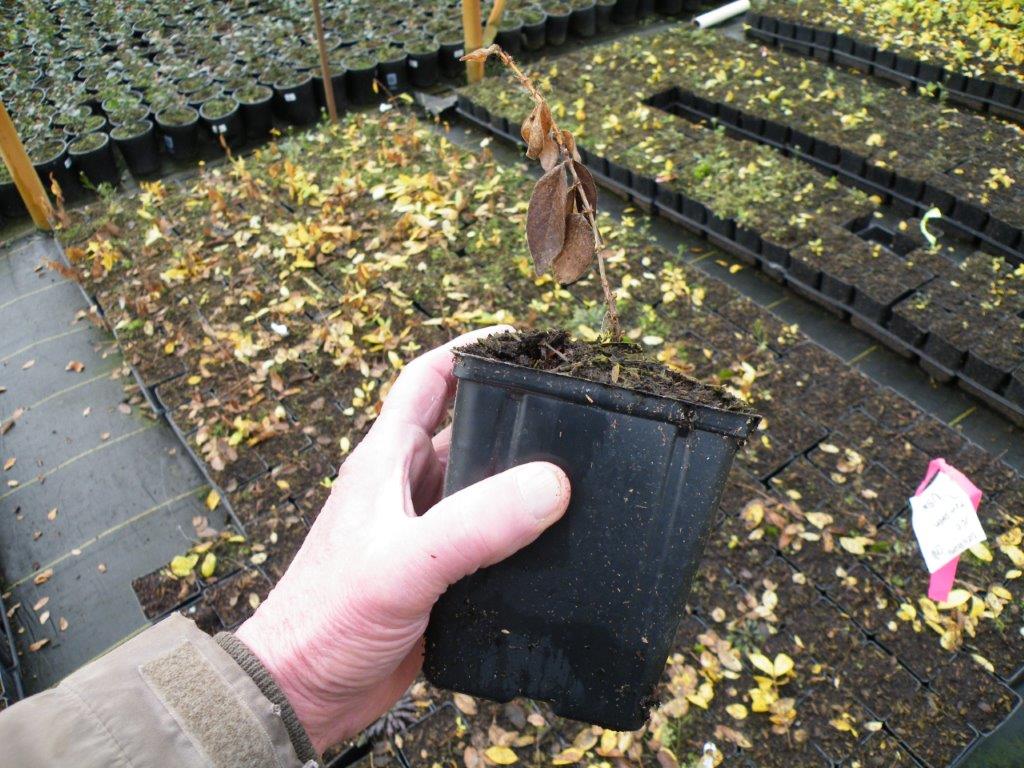
Liter/QT pot size usually has
more developed roots than plugs
with more room to expand
but may or may not have more top growth
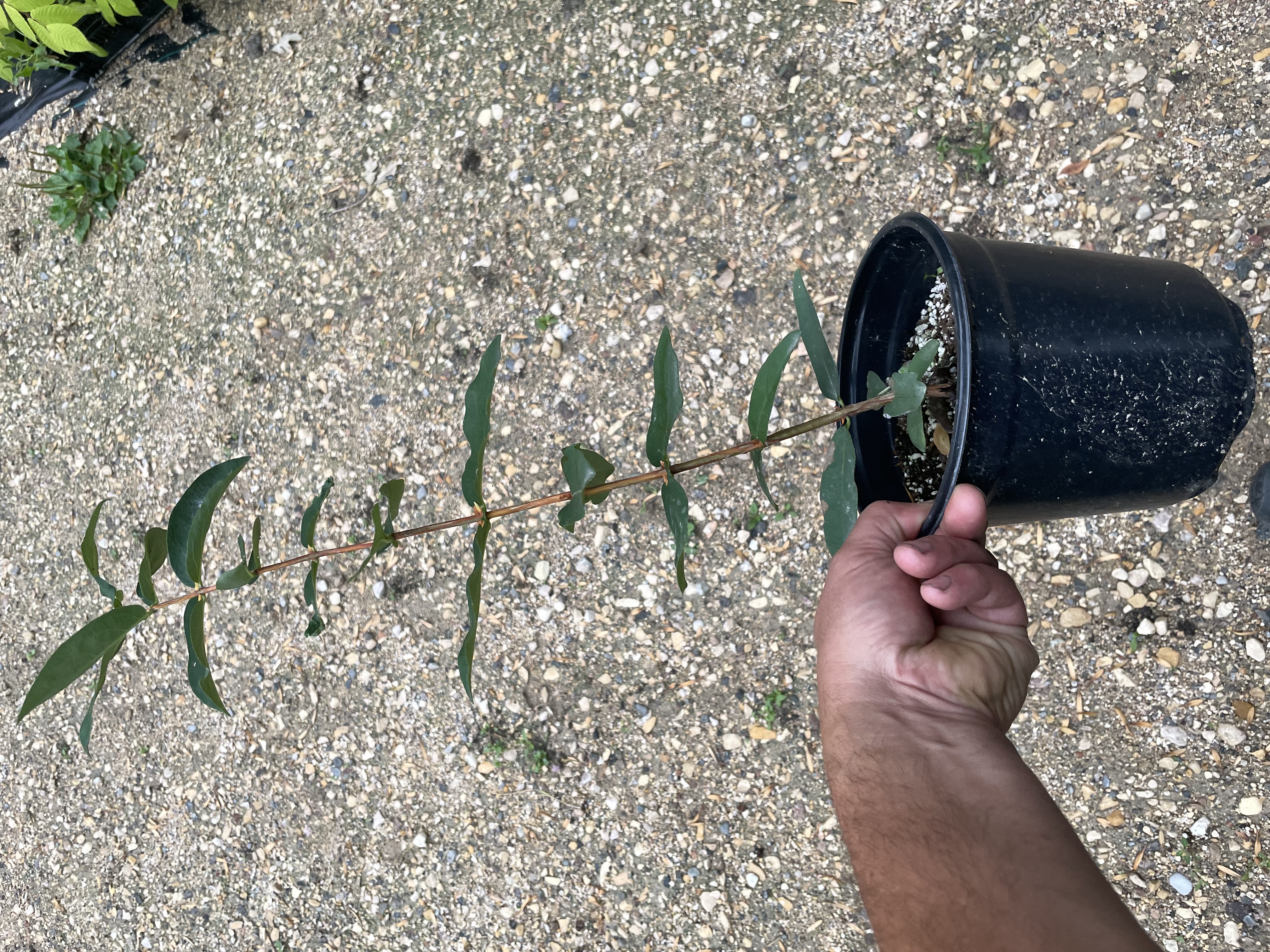
Gal/BR = 2 year old plants
Bare rooted from Gallon pot
or 2 year old field grown (field grown may be a bit smaller or larger than a gallon sized plant)
Nursery 'gallon' (~3 quarts)
also called #1 pot
Orders received early will be prioritized as much as possible for the largest plants

1-2' tall plug (left)
All plants on this page are of the species Lonicera caerulea L. whether they go by the name haskap, honeyberry, or Yezberry(R). In general, "honeyberry" refers to subspecies such as edulis of Russian origin, "haskap" to subspecies with some emphyllocalyx / Japanese origin, and Yezberry(R) of pure emphyllocalyx / Japanese origin. It matters not so much what they are called, but matching the bloom times is critical, as most varieties need a companion for pollination. Each variety will list a recommended pollenizer according to bloom time.
.
.jpg) Tundra berries Tundra berries
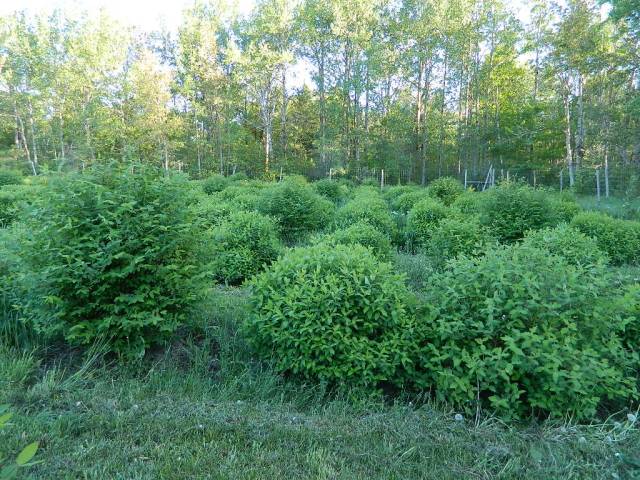 Berry Smart Blue, Borealis, Tundra Berry Smart Blue, Borealis, Tundra
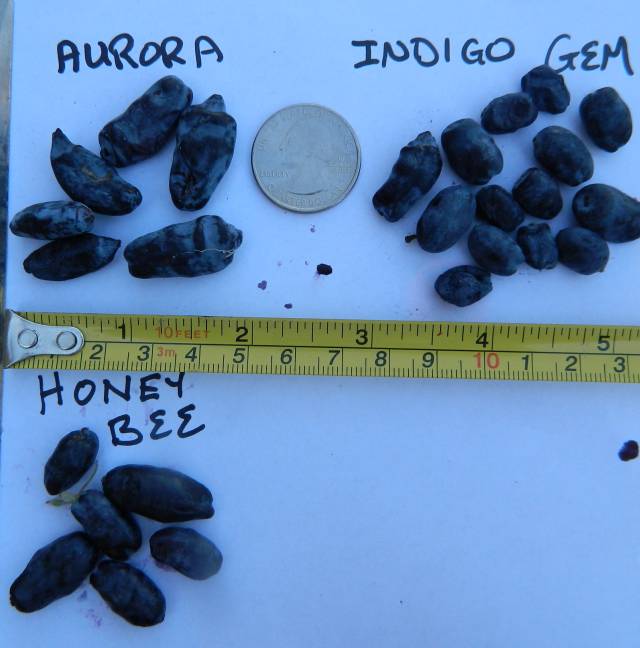 July 5, 2016
3 July 5, 2016
3
 July 11, 2018,
3 July 11, 2018,
3
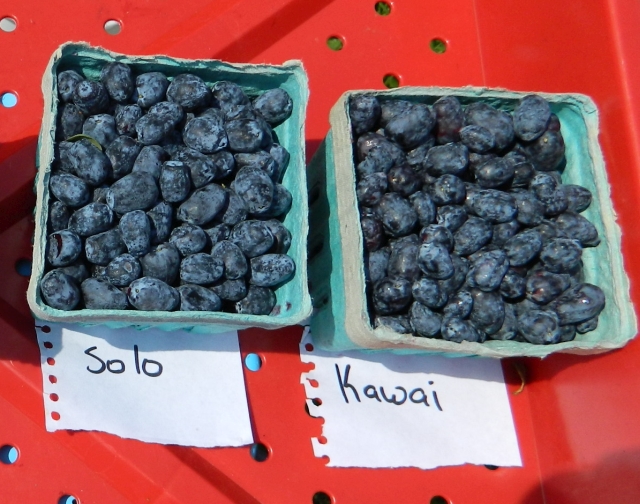 July 11, 2018, Zone 3 July 11, 2018, Zone 3
Ripening: all haskap need approximately 6 weeks from pollination until full ripeness. Blossoms may be pollinated at different times throughout the bloom season, which can run 2-3 weeks, depending on availability of pollinators (bees, other insects) and weather which may accelerate or delay the opening of blossoms and flight of pollinators. So berries do not usually all ripen at the same time but it is quite acceptable to have some tarter berries mixed in with riper ones for processing. Some people enjoy eating tart berries fresh off the bush, others will let the berries ripen as long as possible on the bush. It is difficult to determine ripeness by color alone but if the berry detaches easily, it is most likely quite ripe.
We have a trial orchard with over 50 named varieties and while most of them have good tasting berries, we have selected our favorites to offer to you.
We refer you to another Plant database for even more information.
Which are the sweetest, least tart?
In general, the Japanese varieties from Dr. Thompson’s breeding program are not as zingy as the Russian and Russian-Japanese varieties.
As for the sweetest one, we don't have data on all the brix values and taste is subjective plus it depends how long you let them ripen. A well ripened Russian variety may taste and measure a higher brix (sweeter) than the Japanese that isn't as ripe. But then you have a lower brix like Aurora but less acidity so it tastes sweeter to some people.
So if you want the sweetest possible berry let them ripen until they are about to drop off the plant, and if you want a milder taste stick with the Japanese from Dr Thompson's selections - Solo, Maxie, Kawai, Keiko, Willa, Taka, Tana. As for which of those are sweeter neither Jim nor I have a definitive answer due to all the various factors regarding ripening time, plus it's somewhat subjective. What I can tell you is that I have ordered and tasted very astringent honeyberries and none of these are in that nasty category! Plus I have tried to record as many observations as possible in each description.
If you are only going to order one plants, Solo is the only verified self pollinating one I know of and you would need two to increase production anyways. If you are in doubt I always suggest ordering a selection and hopefully one of them will turn out to be your favorite and the others come in a close second. Hope that helps!
Honeyberries
travel very well and usually bounce back from any shipping damage if given a chance. They usually arrive within 1-4 days, but tolerate a week or more in transit, even when leafed out.
- Planting: spring or fall
- Winter prep: nothing other than normal deer, rabbit and rodent protection
- Growth: Some varieties grow faster and taller than others, typically from 1'-2' a year. They put out most of their fresh growth in early spring, then the stems thicken over the summer. They may put out a couple of stems of new growth in the fall, and even the odd blossom.
- Mulching: helps with weed and moisture control, but be sure to leave a couple inches free around the stem.
- Fertilizer: Moderate applications of time-released fertilizer or aged manure along with regular watering is beneficial.
- Shade/Sun: partial shade to full sun (shade cloth recommended for warmer zones). They struggle in excessive heat and dryness, and in overly wet and windy conditions. They have been grown successfully in full sun as far north as Alaska and in the shade as far south as Georgia and California.
- Early/Late blooming: Early blooming plants may not set fruit in some west coast or warmer climates due to breaking dormancy too early/lack of active pollinators (e.x. bumblebees) at their blossom time.
- Pollination: Order at least one companion variety for every 3-5 other honeyberry plants for adequate pollination.
For a more detailed comparison of honeyberry plants and berries, please see our blog, along with more pics of bushes and berries.
Customer feedback
Quite impressed with my 4 yr. old Auroras and Honey bee. Despite our severe drought we got about 4 lbs from each and we had late frosts that got below 25f. right up to june 23 and they still flowered/ set fruit fine. Frenchville, ME
|
 |
| |
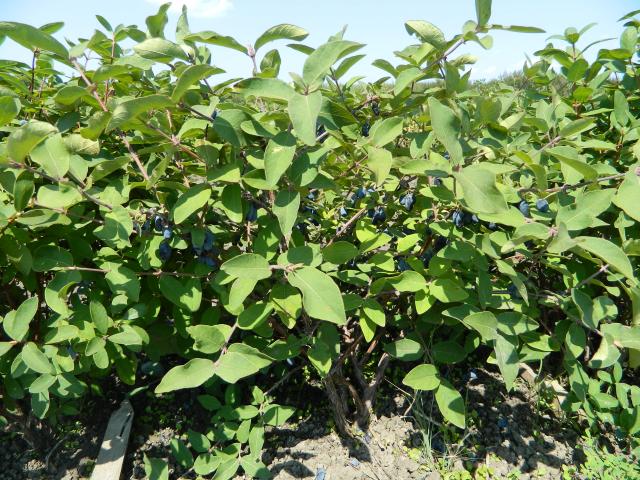 |
|
|
Honeyberry Plants for Sale
* or order a package, each pack below counts as 1 item in shipping calculation:
|
Boreal Series U of S 3-pack Mid-Late Blooming
|
Late Blooming 6-pack XXL/L
|
|
|
$65
zones 2-6
Blizzard/Beauty/Beast
Russian/Japanese genetics
|
$145
zones 2-8
(Our choice of at least 3 varieties larger 2-4 year olds,
such as Keiko XXL and Willa XXL, Kawai L
mostly Dr. Maxine Thompson Japanese varieties)
|
|
Note that for zones 8-9 West Coast, Late bloomers usually fare better.
(We do not guarantee they will survive 8-9 in the southern states, heavy mulchin (wood chips are fine), partial shade or shade cloth and heavy watering are recommended). See Dallas, TX report.
EARLY-MID season selections USDA 2-6+
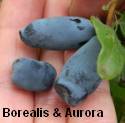
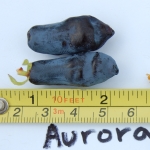
|
|
* Very large berry 2.7 g
* 5-6' tall, 5+' wide
* upright and spreading shape
* USDA zones 2-6 (6 and above experimental, some sites are fine, at other sites Aurora breaks dormancy too early)
* Pollenizers: Blue Banana, Beast, Honey Bee or Indigo Gem, Indigo Treat, Berry Smart Blue, Tundra,
* Note on Borealis as pollenizer: we do not sell Borealis because Borealis berries are harder to harvest & can mold underneath its dense canopy of leaves
Pros
* Our favorite early blooming variety, but very late to ripen, even later than Blizzard/Beast/Beauty.
* One of the largest berries, with fantastic taste, fast grower and very good productivity
* Balance between low sugar and low acid ratio
* Dry scar (stem detaches easily without "bleeding" juice), firm berry with relatively tough skin like Tundra
* Early blooming, ripens after Tundra and Indigo Gem, same as Honey Bee
* Though starts to bloom prior to Blizzard/Beauty/Beast, due to uneven bloom period, the last berries may ripen after this trio.
* Upright growth habit and fewer leaves makes for good visibility and easy picking
* If ordering several plants, we recommend planting the majority Aurora for fresh eating, it is so good all-around!
* Resistent to mildew
* Rated top for Shelf life + fertility + taste criterion by European grower.
* Long ripening period - do not all ripen at same time
Wine: Very good MSU 2020
Cons:
* Uneven ripening
* Its low sugar content may not lend itself to winemaking/distilling as much as other varieties. Reports are that it is not ideal for Mead
More info: Plant Breeder's Rights, Aurora update 2019
Videos: first year, sixth year
Companion pollenizers:
USDA zones 2-4: Blue Banana or Indigo Gem, Tundra, Czech #17
USDA zones 2-6: Boreal Beast
|

.jpg)

|
* Large berry size, avg. 1.9 g
* 5-6' tall, 5'+ wide
* Early-mid blooming, but late ripening (undesirable taste if picked too early)
* Upright growth habit
* Pollenizers: *Aurora* or Indigo Gem, Indigo Treat, Berry Smart Blue, Tundra, Blizzard, Blue Banana
Pros:
* Good for fresh eating or processing
* Fruit has an interesting, light tartness
* Plant holds onto its fruit firmly until berry ripens fully
* As berry ripens, stems detach easily
* Very productive (9 lbs after 5 years)
* Leaves are resistant to sunburn, wind and powdery mildew
Cons:
* Produces so many large berries on plants 5 years or older that branches droop towards ground on otherwise upright growing bush!
* Berries not as frost tolerant as other U of S varieties in a Russian trial (20 nights of frost in April)
* Some stems may stay attached when picking/shaking the berries
* Smaller berry than Aurora
More info: https://research-groups.usask.ca/fruit/documents/haskap/HoneyBee.pdf
Videos: Harvesting, Evaluation
|
EARLY season selections USDA zones 2-5
(ripen earliest, but largely overlap in bloom with Early-Mid ripeners)
Note: One grower in zone 7 in the Smoky Mountains of North Carolina tried, but removed Early Bloomers as "too often, we found that the Indigo Gems, Aurora, Sugar Muntain Blue, Czech #17, and Tundra were opening up too early and succumbing to late freezes.
For West Coast and zones with huge temperature swings in late winter like 80's down to single digits,
Late bloomers fare better.
Note that Indigos & Tundra don't pollinate each other, they need a different companion for pollination such as Aurora or Berry Smart Blue.
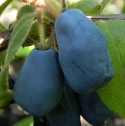

| |
* Early blooming & ripening
* Mature height 4-5', 5'+ wide
* 1.3 g avg berry size
* V-shaped, somewhat open bush
* Pollenizers: *Aurora*, Berry Smart Blue, Honey Bee (Honey Bee may bloom later in zones 5-8), Blue Banana
Pros:
* One of the preferred fresh-eating berries for its sweetness and slightly chewy
texture, with very good productivity.
* First berry along with Tundra and Berry Smart Blue that we harvest in the spring
* Good for processing
* Very good berry for wine
* Higher yield than Tundra
* Resistant to wind damage
Wine: Good MSU 2020
Cons:
* Squatty bush with low hanging branches less than ideal for mechanical harvesting
* Mildly susceptible to powdery mildew but doesn't affect fruit harvest
More info: www.fruit.usask.ca/Documents/Haskap/IndigoHaskap2011.pdf
Videos: Evaluation
|
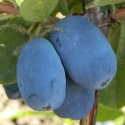

| |
* Mature height 4-5' and 6' width
* 1.49 g avg. berry size
* Early blooming
* Pollenizers: Aurora, Berry Smart Blue, Honey Bee (Honey Bee may bloom later in zones 5-8), Blue Banana
Pros:
* Firm enough for commercial harvesting, yet tender enough to melt in your mouth
* Good for fresh eating as well as baking, we average 2-3 lbs/bush.
* Very easy picking as berries are quite visible
* Berries detach easily from stem (does not easily "bleed", i.e. does not tear where stem detaches)
* Long shelf life (>1 week)
* Excellent berry for wine
Cons:
* Not as high yield as some other varieties
* Squatty, sprawling growth habit not ideal for commercial harvesting
More info: www.fruit.usask.ca/articles/new_varieties.pdf
Videos: 2018 evaluation, 2018 spring
Contact us for availability.
|
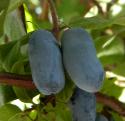
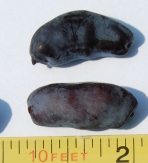
|
* Medium sized berry, tube shape
* 6-10+' tall, 6-10'+ wide
* Pollenizers: *Aurora*, Indigo Gem, Indigo Treat, Tundra, Honey Bee, Blue Banana
Pros:
* Tasty tart berries good fresh or processed, when fully ripe are much less tart
* Early blooming, long bloom, fast growing
* Susceptible to sunburn and powdery mildew, but these issues do not affect fruit production
* Some people like to stand and pick the taller bush
* Shake-n-drop (shaking bush to drop berries) works great
* Our max yield: 14 lbs
* Somewhat astringent berry so not our favorite for wine, only 11 brix, but others prefer it for wine
Cons:
* Leaves sunburn easily
* Slightly susceptible to powdery mildew
* Early dormancy
* Videos: 2018 Comparison
More Info
|
University of Saskatchewan Selections
Boreal Series
Mid to Mid-Late Bloomers - zones 2-8
(Russian + Japanes and/or Kuril Genetics)
Small plants video
Comparison from 795Haskap in Alberta, Canada
Coming in 2026:
Boreal Bliss Haskap
 Blizzard.jpg)
Boreal Blizzard
|
|
Boreal Blizzard was so named because the fruit size, productivity, and flavour stopped the University of Saskatchewan evaluators in
their tracks.
* Ancestry: 50% Japanese, 50% Russian
* Origin: University of Saskatchewan, Dr. Bob Bors, released to market 2016
* Flavour: Excellent, its 'tang' and 'zing' is possibly the best ever (similar to Aurora), some like Aurora better
* Fruit Weight: 2.8 grams avg., 3.9 grams max
* Fruit Shape: 'Surfboard'. Rounded narrower ends, wide centre, a bit flattened
* Fruit Firmness: Good but not as firm as Aurora
* Productivity: Very good. Largest berries but may not yield as many berries as some others.
* Sugars: 13.3 Brix pH: 3.3 Total Acidity: 1.08% Malic Equivalent
* Bush Habit and Vigour: Upright 5'+ height and width
* Mildew and Sunscald Resistance: Excellent
* Bloom Time Category: Late. Peak bloom is 4 to 7 days after Tundra/Indigo series. Similar to many Japanese selections but there are many Japanese
selections that bloom later.
* Pollinizers: Beast, Honey Bee
(Beast begins blooming along with Blizzard. Honey Bee would start a little earlier and overlap approx 80%. The last of the Tundra/Indigo bloom should catch the first 60% of Blizzard (according to zone 2 bloom times). Beauty may overlap the last bit of Blizzard. Aurora is too closely related to be a good pollenizer. Solo™ and Maxie™ Yezberries(R) would overlap approx the last half of Blizzard.)
Pros:
* Flavor and large berry size for fresh eating, upright growth habit
Cons:
* Somewhat susceptible to wind damage
* Softer berry and shorter shelf life than Aurora, not quite as productive as Aurora
More info: https://research-groups.usask.ca/fruit/documents/haskap/Boreal-Blizzard-May-2016.pdf
|
Boreal Beast
 Beast.jpg) Boreal Beast
Boreal Beast
| |
* Ancestry: 50% Japanese, 25% Russian, 25% Kurile
* Bloom Time Category: late, more seasons needed to investigate, Its peak bloom is between the peak bloom of Boreal Blizzard and Boreal Beauty.
* Harvest Season: ripens after Saskatoon berries and just before our dwarf sour cherries, which is late July in Saskatoon
* Fruit Weight: 1.86g (2014), 2.06 (2013)avg.
* Fruit Shape: Thick Heart or thick Oval Fruit Firmness Excellent Flavour Excellent, very nice aroma and aftertaste Brix: 18.2 (2014) 13.0 (2013)
* Total Acidity: 1.8 (2014), 2.16 (2013)
* Bush Habit: Upright 5'+ height and width
* Bush Vigour:Strong
* Mildew Resistance: Excellent
* Productivity: Good
* Commercial uses: Doesn't roll on cleaning table as easily and is a little softer than Beauty
* Pollenizers: Blizzard, Beauty
Pros:
* Very nice aroma, exceptional flavor for juice.
Cons:
* Susceptible to wind damage.
* Shorter shelf life than Aurora or Beauty
More info: https://research-groups.usask.ca/fruit/documents/haskap/Boreal-Beast-May-2016.pdf.
|
Boreal Beauty
(overlaps some with late bloomers)
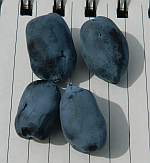 Boreal Beauty Boreal Beauty
| |
* Boreal Beauty was so named as its heart or oval shaped berries should prove to be a beauty not only for their visual appeal but also for its firmness, fruit size, productivity, and flavour. Berries hold on to the bushes with just the right amount of force.
* Ancestry: 37.5% Japanese, 37.5% Russian, 25% Kurile
* Origin: University of Saskatchewan, Dr. Bob Bors, released from propagator 2016
* Flavour: Excellent
* Fruit Weight: 2.6g avg., 3.7g max
* Fruit Shape: Thick Heart or thick Oval
* Fruit Firmness: Excellent
* Sugars: 16.9 Brix pH: 1.87 Total Acidity:
* Bush Habit and Vigour: Upright and sturdy. The original seedling was 50%
taller than 'Indigo Gem' planted at the same time, same field, U of S. 5'+ height and width
* Mildew and Sunscald Resistance: Excellent
* Productivity: Heavy
* Retention: OK, drops more berries than Blizzard or Beast, but very productive
* Commercial harvesting: Very good
* Bloom Time Category: Latest of U of S varieties. Blizzard and Aurora stopped blooming 4 days earlier than Beauty in zone 2 in 2016.
* Pollinizers: Beast, Solo™ and Maxie&trade, Kawai and some bloomtime overlap with other lates such as Keiko™, Tana™, Taka™, Willa™, and , Strawberry Sensation™
Pros:
* Its fruit reminiscient of blue lego bricks - also has a unique flavour and texture, more like blueberry.
Cons:
* Susceptible to wind damage, brittle branches, berries may drop
* More info https://research-groups.usask.ca/fruit/documents/haskap/Boreal-Beauty-May-2016.pdf
|
LATE season selections
Bloom and ripen 7-14 days later than Early/Mid season honeyberries
Grow well in Zones 3-8, trial for zones 2, 9 & 10
BERRIES UNLIMITED
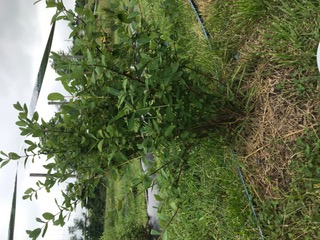 Strawberry Sensation™
Strawberry Sensation™
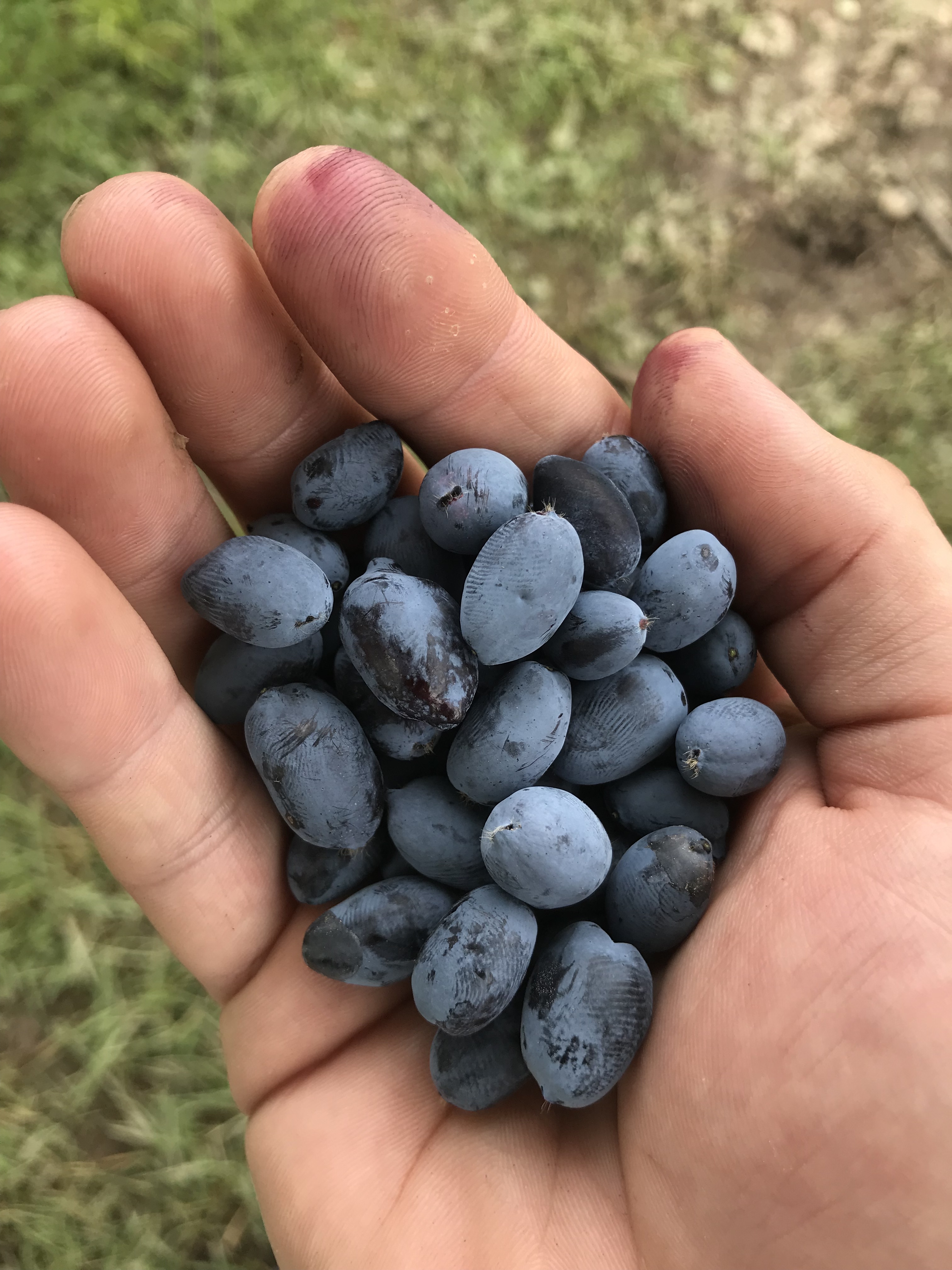
.
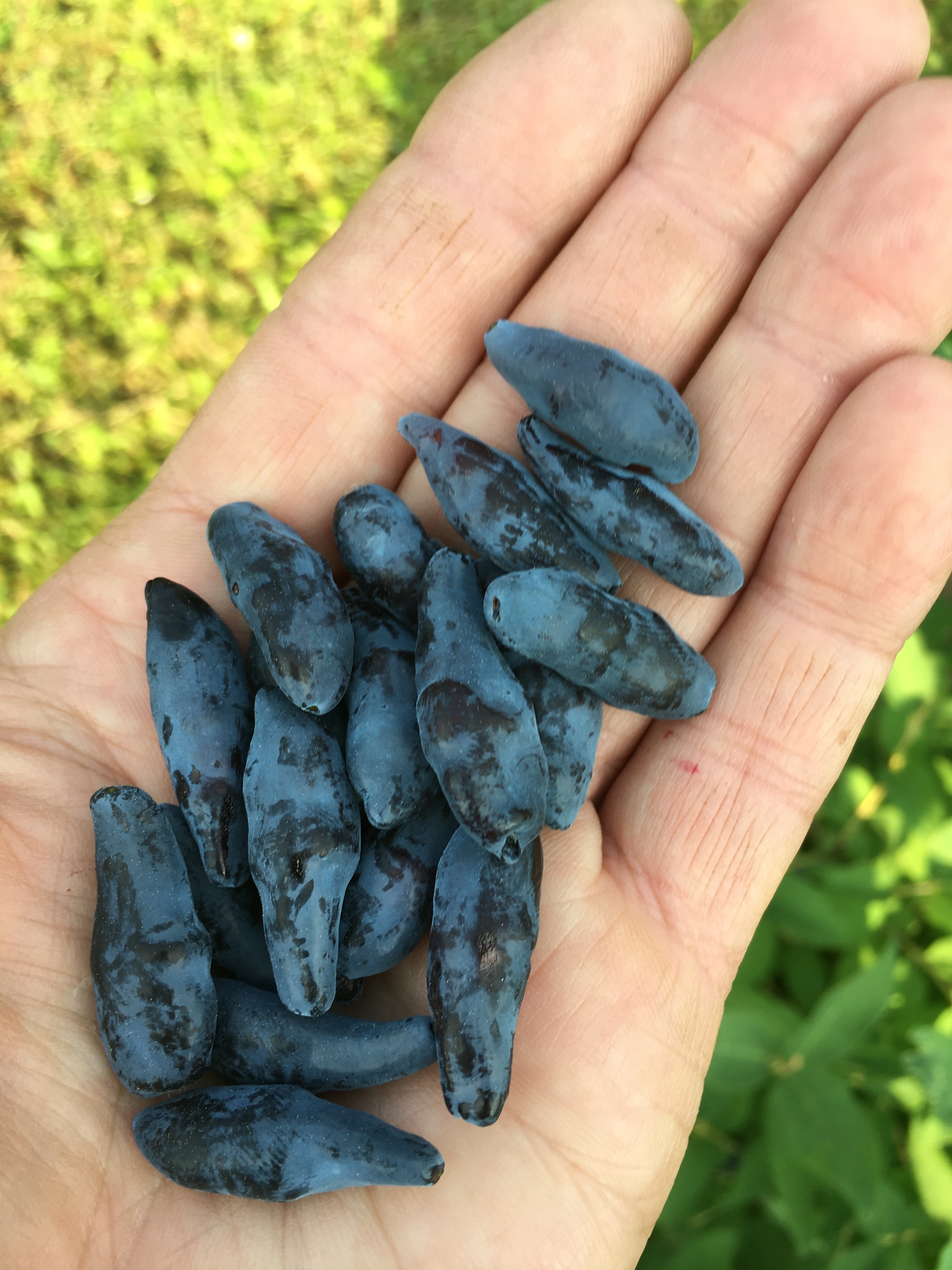 Blue Banana™
Blue Banana™
@Schoen Valley Orchard
| |
Strawberry Sensation™ - Late bloomer
* Ancestry: 100% Japanese
* Breeder: Lidia R. Delafield Stuart, Berries Unlimited
* Bloom Time Category: late, more seasons needed to investigate, Its peak bloom is reported to be with Keiko.
* Fruit Shape: Thick Oval Fruit Firmness Excellent Flavour, very nice strawberry aftertaste
* Bush Habit: Upright
* Bush Vigour:Strong
* Mildew Resistance: Unknown
* Productivity: Excellent (one grower says, "the bush is so polluted with berries it’s almost ludicrous")
* Retention: OK
* Pollenizers: Late varieties such as Beauty, Solo™, Maxie™, etc.
This selection comes to us highly recommended from one of our commercial growers who has many varieties and Strawberry Sensation™ ranks near the top in his opinion as well as his customers' for its "superb" flavor. He asked us to carry it and we are happy to offer it to everyone. Companions/bloom overlap: starts blooming toward the mid or end of Solo, Kawai, Maxie and more overlap with Keiko, Taka, Tana Chito, Blue Mooon ™.
2026 - Please Contact Us to be put on a wait list for plugs May 2026 or fall 2026.
Giant's Heart™ late bloomer
* Ancestry: 100% Japanese
* Breeder: Lidia R. Delafield Stuart, Berries Unlimited
* Bloom Time Category: late, more seasons needed to investigate
* Flavour: Very nice smoked plum aftertaste, sweeter than most others.
* Fruit Shape: Large heart shaped
* Firmness: Firm, detaches easily
* Bush Habit: Upright
* Bush Vigour:Strong
* Mildew Resistance: Unknown
* Productivity: Unknown
* Retention: Unknown
* Pollenizers: Late varieties such as Beauty, Solo™, Maxie™, etc.
This selection comes to us highly recommended from one of our commercial growers who has many varieties and Strawberry Sensation™ ranks near the top in his opinion as well as his customers' for its "superb" flavor. He asked us to carry it and we are happy to offer it to everyone. Companions/bloom overlap: starts blooming toward the mid or end of Solo, Kawai, Maxie and more overlap with Keiko, Taka, Tana Chito.
An excellent variety but unfortunately low availability.
Please Contact Us to be put on a wait list.
Blue Banana™ Early/Mid-season bloomer
* Flavor: Sweet, great for fresh eating as well as processing
* Berry Size & Shape: Large, prolonged oblong
* Ancestry: Russian
* Breeder: Lidia R. Delafield Stuart, Berries Unlimited
* USDA: 2-4, trial in 5-7 AND 8 & 9 on West Coast / 1200 chilling hours
* Pollinizers: Any Early or Early-Mid variety
* Estimated Yield Per Plant: 6-12 pounds
* Recommended Spacing: 5' or mor
Pros: Great for fresh eating, high yield
Cons: susceptible to wind dropping berries
|
Equipment
ATRAX Shaker
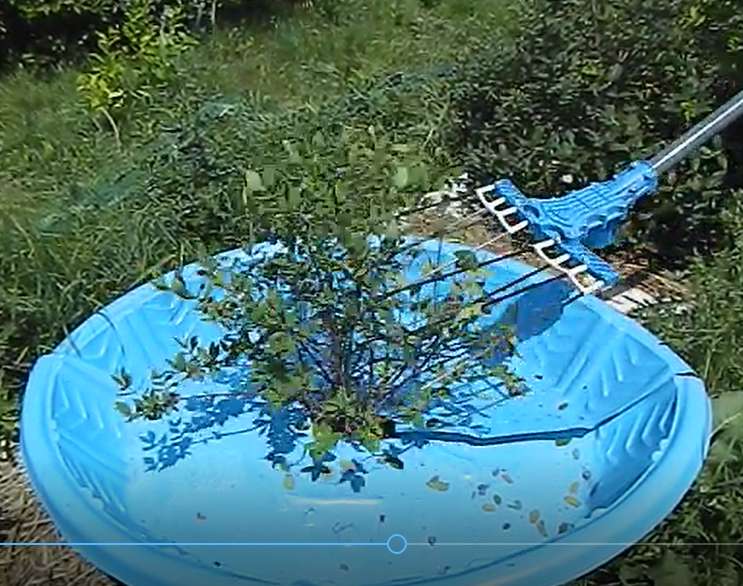 Atrax-4 Shaker
Atrax-4 Shaker
The vibrating carbon fiber teeth shake berries off bushes. Unit is ultra-light (< 7 lbs with 6.5' handle). Runs off a car battery.
Adjustable speed for the rakes from 600-1200 cycles/min.
Rakes with 8 interchangeable teeth, made from a special designed carbon fiber, that can deeply reach within the branches.
HoneyberryUSA ATRAX videos: haskap/honeyberry, tart cherry, juneberry (saskatoon).
Not pictured but works VERY well with currant and gooseberry bushes.
Contact us to reserve your unit. Cost approx $999.
The price includes the head, 750 W powerful brushless DC Motor, 5 ft fixed length aluminum pole, 46 ft extension cable, and 2 interchangeable poles 16 in, and 39 in that fit at the end of fixed length pole. Runs with a car type 12V battery (not included in purchase price). You will need a 12 V Deep Discharge Battery 80-100 A-Hr.
|
|
|
De-Leafer
De-Leafer
De-leafer: Roll the berries down the adjustable slope. Attach a woodworking dust collection unit to suck the leaves up. Order directly from Indigo Super Tech. (Tell them we sent you!)
Will need a woodworking dust collection unit (not included) such as the WEN. Has a bag that inflates. Need to remove screen. Maybe General International would work as well, or mayber GI Portable.
Berry bins not included, available from Glacier Valley.
We store frozen berries in 18x36 3mil Poly Bags from Uline Beware these are not reliable enough to remain leak-proof when berries thaw, but they are a nice size to stack into a chest freezer.
|
|
Honeyberry / Haskap Waxwing Harvester
|
|